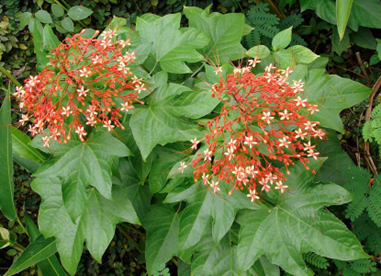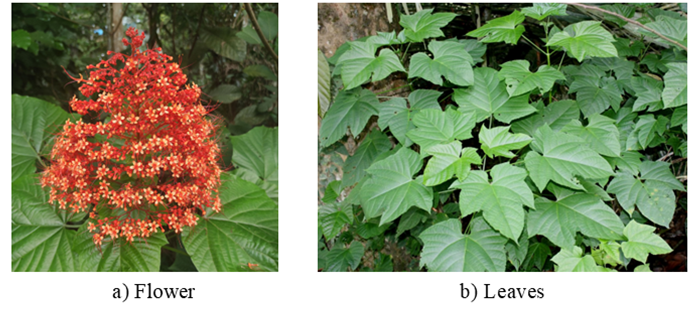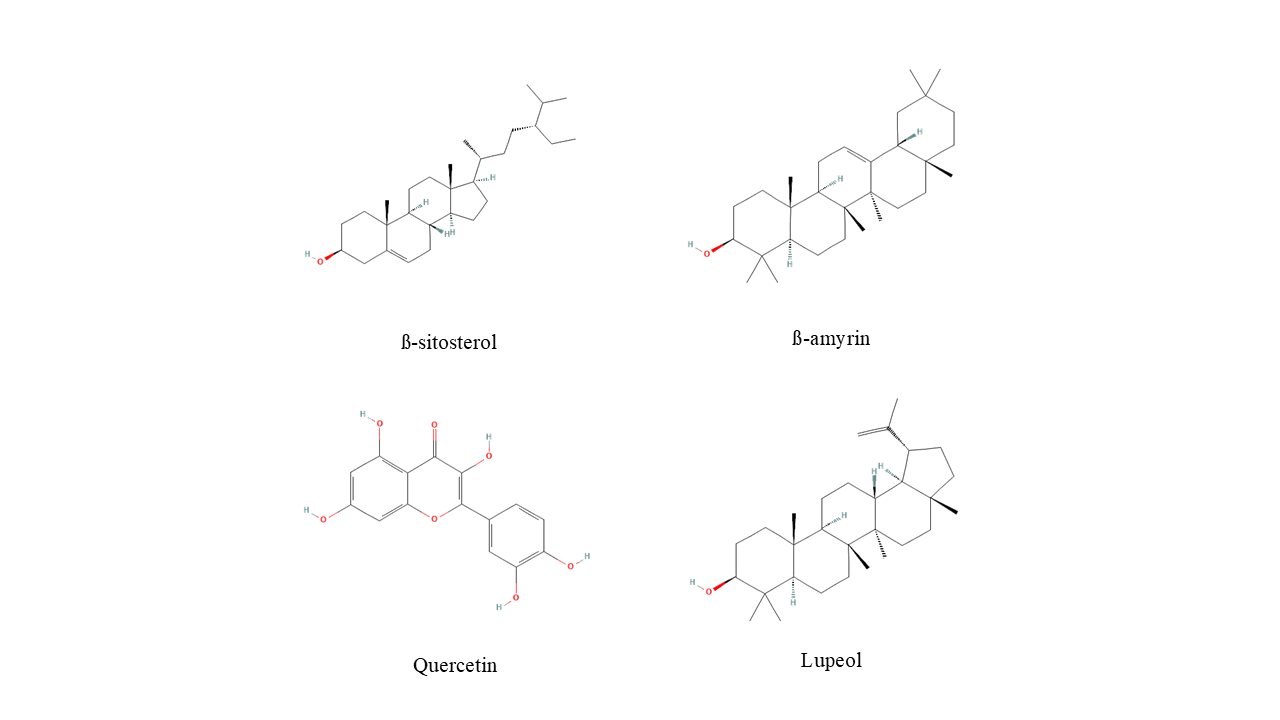Abstract
Clerodendrum paniculatum L., commonly known as the Pagoda flower or Red Glorybower, is a significant medicinal plant species belonging to the Lamiaceae family. This review synthesizes current knowledge about its botanical characteristics, geographical distribution, phytochemical composition, and therapeutic applications. Native to tropical Southeast Asia, this semi-woody shrub is characterized by its distinctive orange-red flowers and large evergreen leaves. Phytochemical analysis has revealed the presence of various bioactive compounds, including phenolics, flavonoids, alkaloids, terpenes, steroids, and glycosides. Traditional medicine systems across Asia have utilized different parts of the plant to treat various conditions, including rheumatism, inflammation, wounds, and women's health issues. Modern pharmacological studies have demonstrated multiple therapeutic properties, including antioxidant, hepatoprotective, anti-inflammatory, antibacterial, anticancer, and antidiabetic activities. The plant's antioxidant properties are attributed to its high flavonoid and phenolic content, while its anti-inflammatory effects are linked to the reduction of pro-inflammatory cytokines and mediators. Additionally, research has shown promising results in its potential as an insecticidal and anthelmintic agent. While C. paniculatum has demonstrated significant therapeutic potential across various applications, further clinical research is needed to fully validate its traditional uses and explore its potential in modern pharmaceutical development. This comprehensive review highlights importance of plant in both traditional medicine and contemporary therapeutic applications, suggesting its potential value in future drug development initiatives
Keywords
Clerodendrum paniculatum, phytochemicals, pharmacological activities, medicinal plant, traditional medicine.
Introduction
A significant amount of the global drug market is made up of plant materials, which are utilized as over-the-counter medications, home cures, and pharmaceutical industry raw materials in both developed and developing nations [1]. The plant species Clerodendrum paniculatum L. (C. paniculatum) belongs to the genus Clerodendrum [2]. The genus Clerodendrum includes subherbaceous perennials, lianas, small trees, and shrubs [3]. The plant is a member of the Verbenaceae family, which is now part of the Lamiaceae family [4]. Other popular names for it are Red Bleeding Heart, Pagoda flower, and Red Glorybower. Numerous nations, including India, Laos, Cambodia, Thailand, Indonesia, and Vietnam, are home to C. paniculatum L. [5]. The plant is either biennial or annual [6]. The plant thrives in bushes and on the slopes of mountains. Few people are aware of its amazing properties, but it is a valuable herb in traditional medicine. For thousands of years, traditional medicine has employed numerous species from the genus Clerodendrum to treat a wide range of illnesses and metabolic conditions in people [2]. The plant bears enormous orange-red or scarlet flowers that are held above its big evergreen leaves [7]. It grows in rocks and can be found in the Andaman and Nicobar Islands. Tribes in the Andaman and Nicobar Islands utilize the plant as an abortifacient [4]. It is used as a medication to treat renal issues, gonorrhea, urinary tract issues, and painful eyes. Preliminary phytochemical screening revealed the presence of terpenes, flavonoids, tannins, alkaloids, phenolic acids, sterols, and glycosides. The herb has great medicinal value and is used to cure skin diseases, pitta wounds, vitrated vata, and inflammatory ulcers. A root decoction is used as an aching and pain tonic. In India, China, and Japan, it has long been used to treat rheumatism, neuralgia, ulcers, inflammation, and wound healing [8]. It has been utilized as an antipyretic and anti-inflammatory medication in traditional Thai medicine [7]. This plant is also used to cure wounds, snake bites, bodily aches, jaundice, and eye pain in Iceland and Indonesia. Furthermore, leukorrhoea, vaginal discharge, irregular menstruation, uterine irritation, and a number of other women’s disorders are treated with C. paniculatum [5]. Clerodendrum paniculatum is a common plant in Udupi district of Karnataka, India. The genus, which includes small trees, shrubs, and plants, is well-known for its decorative use [7]. In the genus Clerodendrum, more than 550 species are reported to be identified. There are over 550 species known to exist in the genus Clerodendrum. With over 580 species recognized, Clerodendrum is a fairly vast and diverse genus that is found all over the world [6]. Rajendran and Daniel recorded 23 species in India, with Srivastava and Choudhary recording 16 of those species from Arunachal Pradesh. They thrive in rainforests with waste water, frequently near freshwater [7].

Fig No. 1: Clerodendrum paniculatum plant

Fig No. 2: Morphology of Clerodendrum paniculatum a) Flower b) Leaves
Scientific Classification [9]
Table No. 1: Scientific classification of Clerodendrum paniculatum
|
Taxonomic Rank
|
Classification
|
|
Kingdom
|
Plantae
|
|
Class
|
Dicotyledones
|
|
Order
|
Lamiales
|
|
Superorder
|
Asteranae
|
|
Family
|
Lamiaceae
|
|
Domain
|
Eukaryote
|
|
Phylum
|
Spermatophyta
|
|
Subphylum
|
Angiospermae
|
|
Genus
|
Clerodendrum
|
|
Species
|
Clerodendrum paniculatum
|
Vernacular Names [10, 11]
Table No. 2: Regional names of Clerodendrum paniculatum in different languages
|
Language
|
Regional Name(s)
|
|
English
|
Pagoda flower, Orange Tower Flower
|
|
Tamil
|
Krishna kireedam
|
|
Kannada
|
Ratha pushpa, Ratha hoo
|
|
Malayalam
|
Hanuman kireedam, Krishna kireedam
|
|
Malay
|
Pangil pangil
|
|
Sanskrit
|
Krishna kireeta
|
Geographical Distribution
With almost 500 species, the genus Clerodendrum L., which was formerly a member of the Verbenaceae family, is now a member of the Lamiaceae family. The genus Clerodendrum L. is found worldwide in tropical and subtropical areas. Because of the terminal panicles’ striking orange-red to crimson flowers, it is primarily grown as an ornamental plant in gardens. It can be found all across tropical Southeast Asia, including Bangladesh, Indonesia, China, Taiwan, Laos, Cambodia, Vietnam, Malaysia, Sri Lanka, and India. Southern China, including Taiwan, Indochina, Bangladesh, Sri Lanka, Andaman & Nicobar Islands, Borneo, Sulawesi, Sumatra, the Philippines, and the Bismarck Archipelago, is where it originated [5,12,13].
Description Of the Plant
The shrub C. paniculatum L. is upright and semi-woody. The plant is roughly 2.5 meters tall, has many branches, and is 0.6 to 0.9 meters wide. Huge orange-red or scarlet blossoms are held above the plant's massive evergreen leaves. The plant is firmly supported by the large, sturdy roots, which have a fibrous, branching structure. The roots’ vascular cylinder and cortex are both well-developed anatomically, and their many root hairs increase their surface area, which facilitates effective water and nutrient absorption. The bases of the leaves are heart-shaped; the upper leaves are whole, while the lower leaves are lobed. The leaves have a maximum diameter of 30.5 cm. They have shallow lobes, are cordate-ovate, three to seven lobed, and are membrane-bound. The petiole is up to 30 cm long with an acuminate tip, and the leaf margins are glandular underneath and minutely denticulate. Large terminal panicles hold the flowers in place. The calyx is separated almost to the base and ranges in colour from red to orange-red. The lobes are around 7 mm long, and the corolla is orange-red to crimson with a thin tube up to 2 cm long. Almost all year long, flowers are produced. The fruit is round, bluish-black, drupe-shaped, and about 1 cm in diameter [7,10].
Phytoconstituents
Clerodendrum L. members have been shown to contain a wide variety of phytochemicals, with over 280 phytochemicals from various Clerodendrum species having been reported. Phenolics, steroids, di and tri terpenes, flavonoids, alkaloids, tannins, sterols, glycosides, volatile oils, oleanolic aldehyde acetate, ?-sitosterol, lupeol, stigmasta-4,25-dien-3-one-22E-stigmasta-4,22,25-trien-3-one, and 3?-stigmasta-4,22,25-trien-3-ol are among the chemical components reported from the genus. The roots of C. paniculatum provide chemicals such as ?-amyrin, ?-sitosterol, and (24s)-ethylcholesta-5,22,25-triene-3?-ol. Glycosides, alkaloids, reducing sugars, carbohydrates, tannins, flavonoids, quinones, terpenoids, diterpenoids, phenols, rutin, quercetin, phytosterols, coumarins, and amino acids were all present in the leaves of C. paniculatum. The phytochemical screening of the flower extract showed the presence of proteins, steroids, flavonoids, phenolics, carbohydrates, and tannins. Several chemicals, including alkaloids, glycosides, carbohydrates, flavonoids, saponins, tannins, protrins, and phenols, were found in the stems of Clerodendrum paniculatum after phytochemical screening. Terpenes were also reported, including glutinol, poriferasta-5,22E, triacatane, clerodin, clerodendrin A, 3B-acetylloleanolicacid, 3?- acetylloleanolic aldehyde, and 25-trien-3?-ol [12-15].

Fig No. 3: Representative Chemical Structures of Phytoconstituents in Clerodendrum paniculatum
Medicinal Uses
Multiple Clerodendrum species have been documented to have ethnomedical value in a variety of indigenous medical systems and as folk remedies. According to reports, several species of Clerodendrum have anti-inflammatory, anti-diabetic, anti-cancer, and anti-malarial qualities. The leaves, roots, and other parts of Clerodendrum paniculatum are said to have anti-oxidant, anti-inflammatory, hepatoprotective, and anti-diabetic properties. Particularly in the Indian, Chinese, Thai, Korean, and Japanese medical systems, the species is used as medicine to treat a number of serious illnesses, including cancer, syphilis, typhoid, jaundice, and hypertension. It has been stated that the powder/paste form and the different extracts of roots, stems, and leaves are used as medications to treat lung, blood, skin, and asthma conditions as well as cataracts, malaria, and other conditions. Laxative, diuretic, analgesic, anti-inflammatory, anti-tumor, and antibacterial properties have all been documented for the roots [1,12,16].
Pharmacological Activities
Anti-oxidant activity
With an IC50 value of 64.898 ppm for the pagoda flower ethanol extract and 27.73376 ppm for the pagoda leaf extract, these two extracts exhibit high antioxidant activity [17]. Phytochemical examination of the floral extract revealed the presence of proteins, steroids, flavonoids, phenolics, carbohydrates, and tannins. The primary markers of antioxidant activity in herbals are thought to be the presence of flavonoids and phenolics [18].
Hepatoprotective activity
The presence of glyceric acid, gallic acid, pilocarpine, pangamic acid, and quercetin, either separately or in combination, may be responsible for the hepatoprotective properties of C. paniculatum flowers, according to analyses [18].
Anti-inflammatory activity
By lowering the release of pro-inflammatory cytokines (TNF-?) and inflammatory mediators (NO, PGE2), the root extract of C. paniculatum demonstrated anti-inflammatory potential [19]. The traditional applications of leaves of Clerodendrum paniculatum Linn. in inflammation have been scientifically supported by another study, which found that the leaves’ strong anti-inflammatory properties are caused by the presence of terpenoids and flavonoids [20]. At 50 mg/kg, C. paniculatum leaf ethanol extract also has anti-inflammatory properties [17].
Mutagenic and anti-mutagenic effect
According to a study, C. paniculatum root extract was non-mutagenic and could prevent S. typhimurium strains TA98 and TA100 from becoming mutagenic when exposed to a nitrite-treated 1-aminopyrene mutagen [19].
Anti-bacterial activity
The powdered samples of C. paniculatum leaves and flowers have good qualitative and quantitative characteristics that support prolonged shelf storage and the extraction of bioactive phytochemicals, according to proximate analysis. Due to the high concentrations of flavonoids and polyphenols in the plant extracts, the extracts of both plant sections demonstrated strong concentration-dependent antibacterial activity against B. subtilis and E. coli [5].
Anticancer activity
The ethanolic extract of roots of Clerodendrum paniculatum showed anti-cancer activity by using liquid tumor model but to a lesser extent. The extracts decreased the tumour volume in solid tumour model and that result was not that much significant compared to standard cisplastin. The concentration dependent scavenging of DPPH, ABTS, and O Phenanthroline were studied with the concentrations of 2µg/ml to 1024µg/ml. several antioxidant phenolic compounds have been recognized to have ability to induce apoptosis in various tumour cells of human origin. [7]
Anti-diabetic activity
According to a study, phytochemicals including flavonoids, alkaloids, phenolic compounds, tannins, terpenoids, glycosides, saponins, carbohydrates, amino acids, and proteins are what provide Clerodendrum paniculatum leaf chloroform extract its strong anti-diabetic properties [21].
Insecticidal activity
The insects Helicoverpa armigera and Spodoptera litura were screened for insecticidal activity. It was evaluated using crude ethanolic extracts of Clerodendrum paniculatum leaves. The antifeedant assay, growth inhibitory assay, and larval mortality assay are the methods utilized to conduct analysis. The extract demonstrated insecticidal efficacy that was moderately dosage dependent [22].
Anthelmintic activity
Praveen et al. measured how long it took for the earthworm Eudrilus eugeniae to become paralysed and die after being exposed to different solvent extracts of C. paniculatum leaves. Furthermore, compared to aqueous, chloroform, and ethyl acetate extracts, the study found that the methanol extract has notable activity [23].
CONCLUSION
Clerodendrum paniculatum Linn. is widely used in both traditional and modern medicine due to its decorative and therapeutic qualities. Its pharmacological potential is highlighted by its extensive phytochemical profile, which includes flavonoids, alkaloids, and phenolic chemicals. The plant is a prime example of nature’s extensive medicinal store, with uses ranging from anti-inflammatory and hepatoprotective to antibacterial and antioxidant qualities. Despite its wide range of traditional applications, more thorough investigation is necessary to support its therapeutic claims and investigate novel drug development opportunities, especially in clinical trials. By bridging ethnobotanical knowledge and scientific investigation, Clerodendrum paniculatum Linn. emerges as a promising candidate for future pharmaceutical advancements.
REFERENCES
- Leena PN, Aleykutty NA. Isolation and spectral identification of quercetin from the alcoholic root extract of Clerodendrum paniculatum Linn. Int J Pharma Sci Res. 2016;7(1):47-50.
- Joseph J, Joseph L, George M, Bindhu AR. Phytochemical screening and antioxidant activity of various extracts of Clerodendrum paniculatum Linn. World J Pharm Res. 2018;7(13):555-68.
- Shanbhag P, Bhat R, Shabaraya AR. Protective effect of Ventilago maderaspatana bark extract against various ulcer models in rats. Asian J Pharm Res. 2024;14(1):90-94.
- Jiji Mohan MU, Narkilli SN, Prashobh, Surabhi GS, Kurup SB, Rupitha NS. Review on pharmacological activities of Clerodendrum paniculatum Linn. Int J Pharm Res Appl. 2021;6(6):693-700.
- Nguyen TQ, Hoang XT, Bui TT. Biochemical composition, polyphenol and flavonoid content, antibacterial activity of leaf and flower extracts of Clerodendrum paniculatum distributed in Thua Thien Hue Province, Viet Nam. Trop J Nat Prod Res. 2024;8(9):8275-81.
- Joseph J, Akhila S, Presannakumaran PN, Mathews SM. Phytochemical characterization of the leaf extract of Clerodendrum paniculatum Linn. JETIR. 2021;8(5):994-6.
- Remya K, Smitha Rani, Bency Baby T, Rasheed SP, Azeem AK. Monograph of Clerodendrum paniculatum. World J Pharm Res. 2019;8(8):448-56.
- Priyanka K, Kuppast IJ, Gururaj SV, Chethan IA. Screening of aerial parts of the plant Clerodendrum paniculatum Linn for anti-convulsant activity. Res J Pharmacology Pharmacodynamics. 2019;11(1):1-4.
- Pavithra TR, Sukumaran A, Ajith Babu TK. Ethnomedicinal uses, phytochemical and pharmacological evaluation of Clerodendrum paniculatum: A comprehensive review. Int J Pharm Res Appl. 2023;8(5):1697-703.
- Kekuda TRP, Sudharshan SJ. Ethnobotanical uses, phytochemistry and biological activities of Clerodendrum paniculatum L. (Lamiaceae): A comprehensive review. J Drug Deliv Ther. 2018;8(5-s):28-34.
- Mohan MU J, Narkilli SN, Prashobh, Surabhi GS, Kurup SB, Rupitha NS. Review on Pharmacological Activities of Clerodendrum paniculatum Linn. Int J Pharm Res. 2021;6(46):693-700.
- Joseph J, Joseph L, George M, Bindhu AR. Phytochemical screening and antioxidant activity of various extracts of Clerodendrum paniculatum Linn. World J Pharm Res. 2018;7(13):555-68.
- Hegde NP, Hungund BS. Phytochemical profiling of Clerodendrum paniculatum leaf extracts: GC-MS, LC-MS analysis and comparative evaluation of antimicrobial, antioxidant & cytotoxic effects. Nat Prod Res. 2023;37(17):2957-64.
- Yasire B, Astutis AD, Raihan M, Natzird R, Subehan, Rohman A, Alam G. Optimization of pagoda (Clerodendrum paniculatum L.) extraction based on analytical factorial design approach, its phytochemical compound, and cytotoxicity activity. Egypt J Chem. 2022;65(9):421-30.
- Pavithra TR, Sukumaran A, Ajith Babu TK. Pharmacognostical studies on stems of Clerodendrum paniculatum. Int J Res Publ Rev. 2024;5(8):2778-87.
- Kopilakkal R, Chanda K, Balamurali MM. Hepatoprotective and Antioxidant Capacity of Clerodendrum paniculatum Flower Extracts against Carbon Tetrachloride-Induced Hepatotoxicity in Rats. ACS Omega. 2021;6(40):26489-98.
- Hafiz I, Ginting M, Yuermaileni. Antioxidant activity of pagoda flower (Clerodendrum paniculatum L.) ethanol extract using visible spectrophotometric method. Indones J Pharm Clin Res. 2019;2(2):14-19.
- Kopilakkal R, Chanda K, Balamurali MM. Hepatoprotective and antioxidant capacity of Clerodendrum paniculatum flower extracts against carbon tetrachloride-induced hepatotoxicity in rats. ACS Omega. 2021;6(40):26489-98.
- Phuneerub P, Limpanasithikul W, Palanuvej C, Ruangrungsi N. In vitro anti-inflammatory, mutagenic and antimutagenic activities of ethanolic extract of Clerodendrum paniculatum root. J Adv Pharm Technol Res. 2015;6(2):48-52.
- Joseph J, Bindhu AR, Aleykutty NA. In vitro and in vivo anti-inflammatory activity of Clerodendrum paniculatum Linn. leaves. Indian J Pharm Sci. 2013;75(3):376-9.
- Venkatesh S, Aswani K, Asharaf VV, Anjitha P, Suresh A, Babu G. Anti-diabetic activity of Clerodendrum paniculatum leaves by in vitro, in vivo and ex vivo methods. GSC Biol Pharm Sci. 2021;16(1):211-8.
- Jadhav GS, Devarshi AA, Yankanchi SR. Efficacy of certain Clerodendrum leaf crude extracts against cutworm, Spodoptera litura Fab and cotton bollworm, Helicoverpa armigera Hub. Journal of Entomology and Zoology Studies, 2016; 4(4):466-472.
- Praveen M, Radha K, Padmaja V, William H, Ajithkumar P. In vitro anthelmintic activity of Clerodendrum paniculatum Linn leaves. Res J Pharm Biol Chem Sci. 2013;4(2):321.


 Ramdas Bhat*
Ramdas Bhat*
 Wandaphi Kharbyngar
Wandaphi Kharbyngar
 A. R. Shabaraya
A. R. Shabaraya



 10.5281/zenodo.14726262
10.5281/zenodo.14726262